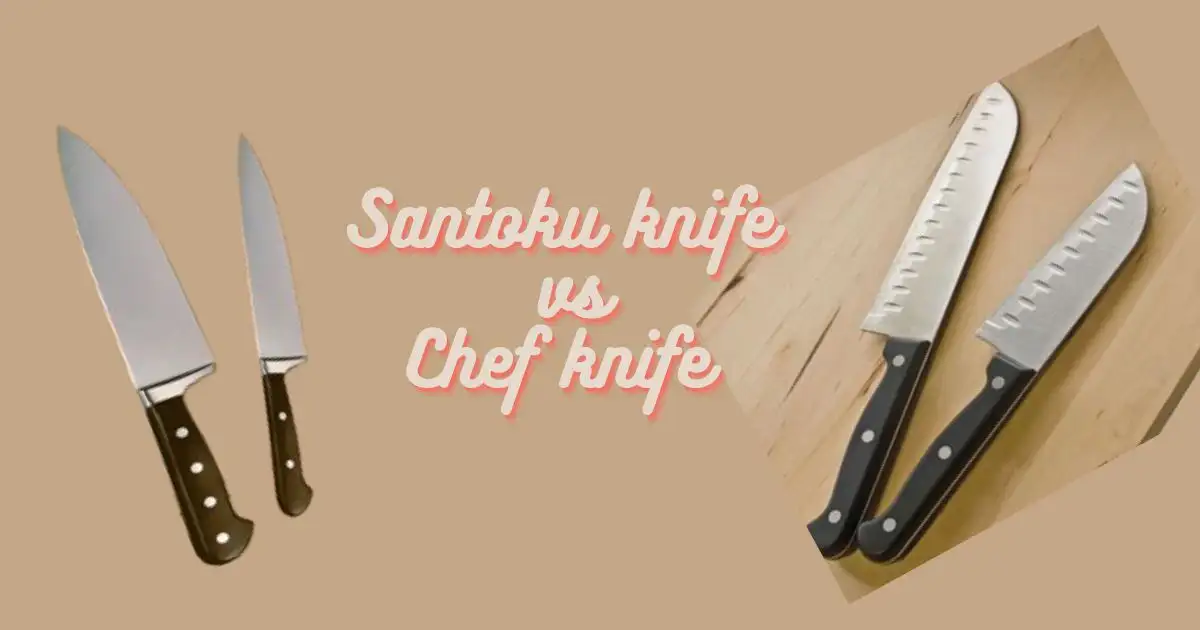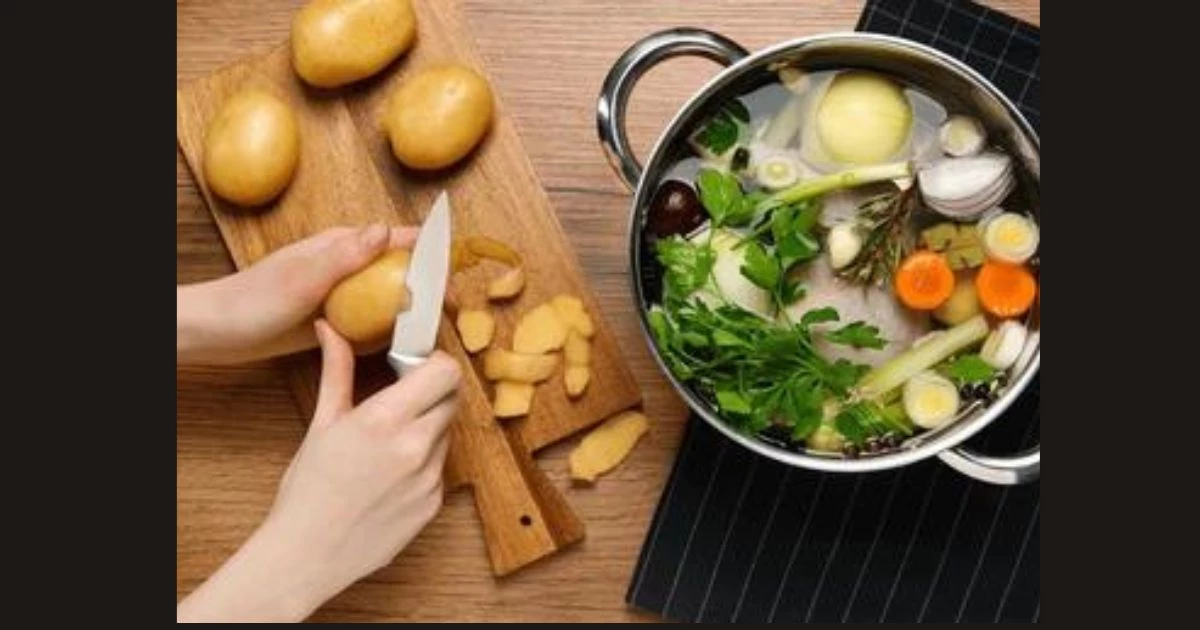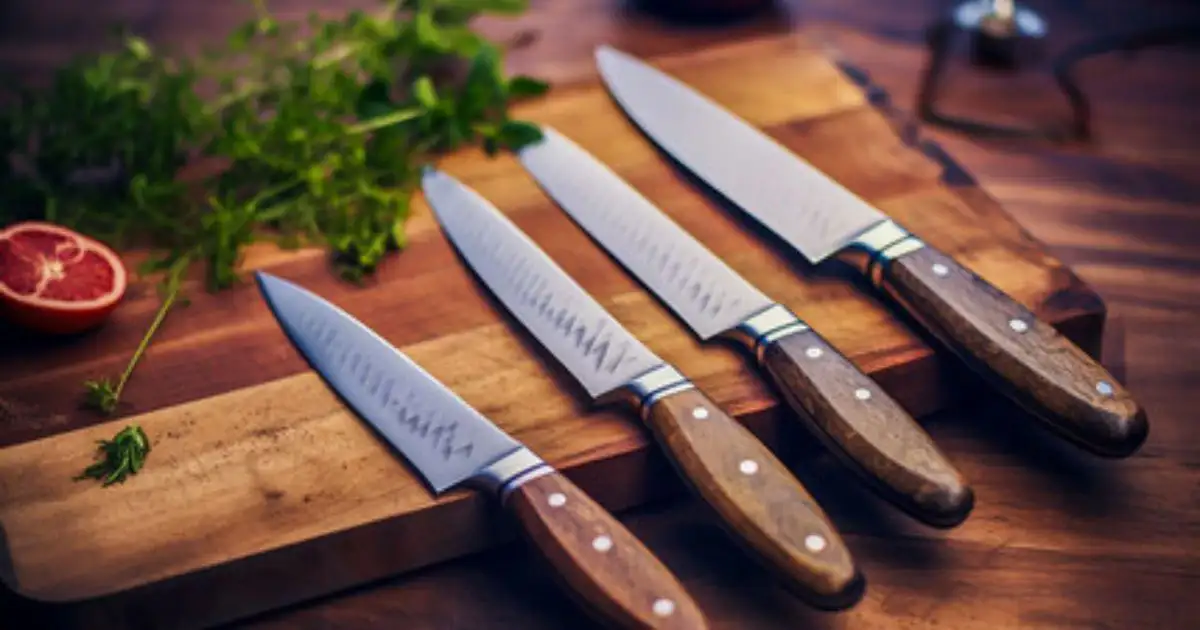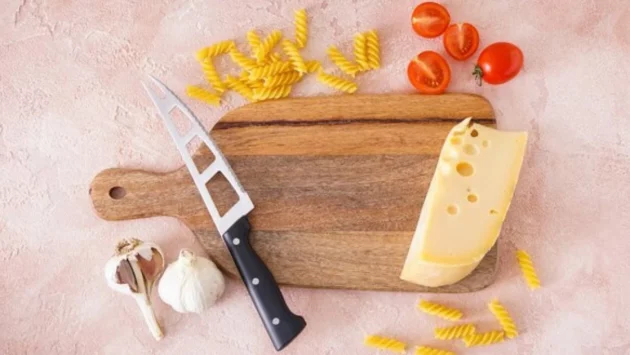Santoku knife vs. chef knife
Table of Contents
ToggleIntroduction
In the dynamic world of culinary arts, the choice of kitchen tools plays a pivotal role in shaping the outcome of our gastronomic endeavours. Among the array of knives available, the Santoku and Chef’s Knife stand out as quintessential instruments, each possessing distinct attributes tailored to specific culinary tasks.
The decision between these two knives can significantly impact the efficiency and precision of your cooking. As we delve into the nuanced differences between Santoku and the chef’s knife, this comprehensive guide aims to empower you with the knowledge needed to discern when to reach for one over the other. Whether you’re a seasoned chef or an aspiring home cook, understanding the unique characteristics and optimal use cases of these knives will undoubtedly elevate your culinary experience.
So, let’s embark on a journey to unravel the secrets behind the Santoku and chef’s knife, helping you make informed decisions and enhance your prowess in the kitchen.
What are the benefits of using the appropriate knife?
The kitchen is a realm where creativity and precision converge, and the choice of the right tools serves as the bedrock of culinary mastery. Among these tools, the knife stands as a symbol of dexterity, capable of transforming raw ingredients into culinary masterpieces.
The importance of selecting the right knife for various cooking tasks cannot be overstated; it is a decision that transcends mere convenience and delves into the realms of efficiency, safety, and the ultimate quality of your culinary creations. Different knives are designed with specific features to excel in particular tasks, and understanding these nuances is akin to wielding the right brush for an artist or the perfect tool for a craftsman.
As we navigate the intricate landscape of the culinary arts, the ability to discern which knife to use becomes an indispensable skill, elevating the cooking experience from mundane to extraordinary. In this pursuit of culinary excellence, the right knife is not merely a utensil but a trusted ally, unlocking the doors to precision, finesse, and the joy of creating flavours that tantalize the palate.
What is a Santoku knife?
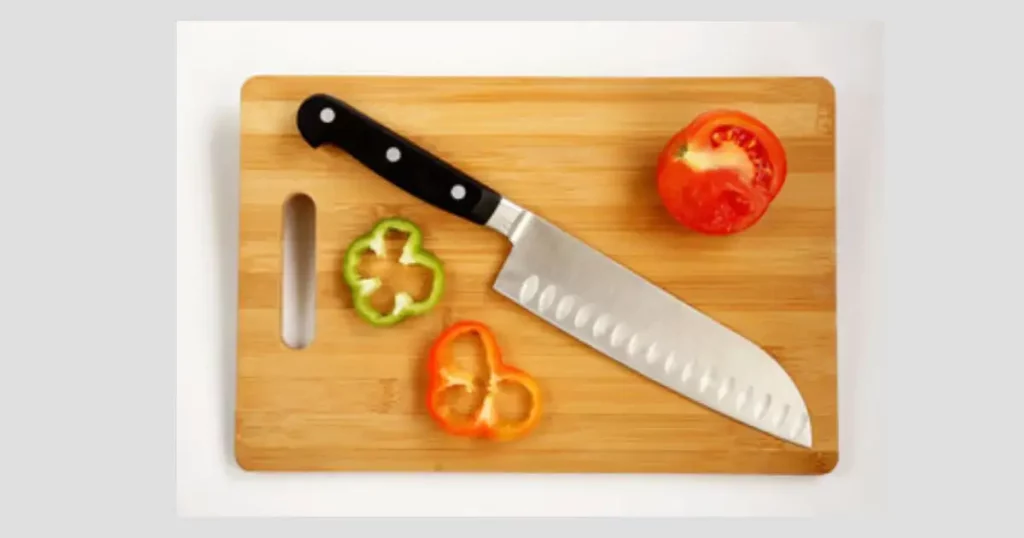
Understanding the Santoku knife involves exploring its origin, distinctive characteristics, and the tasks for which it is best suited. Hailing from Japan, the Santoku, which translates to “three virtues” or “three uses,” embodies its multifunctional nature. The blade typically ranges between 5 and 7 inches, featuring a flat edge near the heel and a more pronounced curve towards the tip. Unlike the chef’s knife, the Santoku lacks a pointed tip, contributing to its unique slicing and chopping capabilities.
Santoku knives are renowned for their exceptional balance, often being lighter than their Western counterparts. The blade is typically thinner, allowing for precision slicing and dicing with minimal effort. The Granton edge, a series of small divots along the blade, reduces friction and prevents food from sticking during cutting.
These knives excel in tasks such as slicing, dicing, and precision cutting. The flat edge facilitates a straightforward up-and-down chopping motion, while the curved belly enables a slight rocking motion for efficient chopping of herbs and vegetables. Santoku knives are particularly well-suited for tasks where a delicate touch and precise control are crucial, making them a versatile choice in the kitchen.
Maintenance-wise, Santoku knives benefit from regular honing and sharpening to maintain their keen edge. Understanding the unique features and optimal use cases of the Santoku knife empowers chefs and home cooks alike to wield this Japanese gem effectively, adding a touch of finesse to their culinary repertoire.
What is a chef's knife?
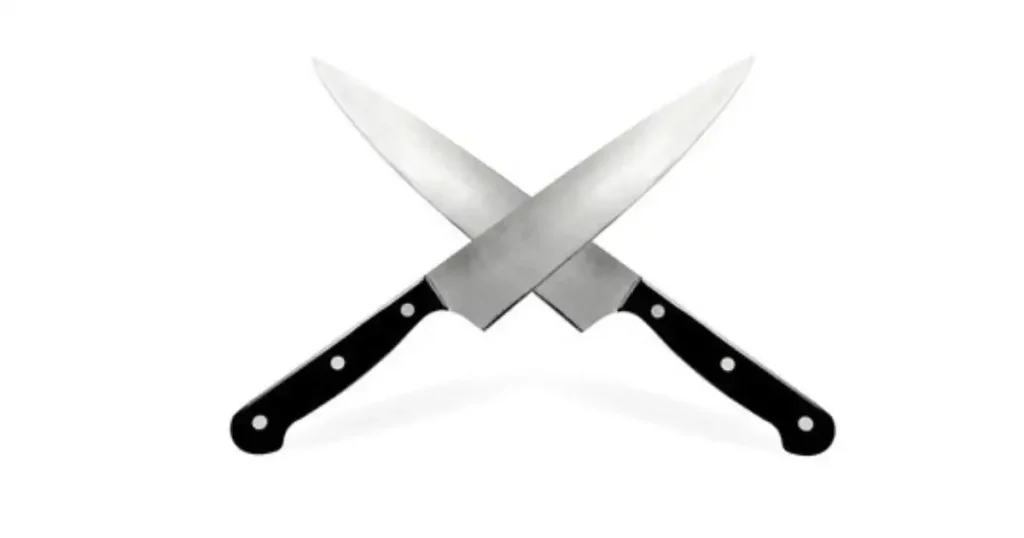
Understanding the chef’s knife involves exploring its origins, key features, and the versatile range of tasks it is designed to perform.
The flexibility of the chef’s knife spreads to its aptitude to hold a variety of elements, including meats, root vegetables, and aromatic plants. The pointed tip allows for intricate work, such as precise cuts and scoring. Whether your contravention depressed a chicken, excellently cutting garlic, or cutting up through a slight tomato, the chef’s knife is the go-to tool for a lot of kitchen requests.
Correct care, as well as fixed success and improvement, is the key to keeping the chef’s knife in ideal condition. With its skill to regulate many cutting lessons and tasks, the chef’s knife remains a critical tool in the kitchen, representing the life force of flexibility and good society for chefs and cooking enthusiasts alike.
When to use a Santoku knife?
Knowing when to use a Santoku knife involves understanding its unique features and optimal applications in the kitchen. Here’s a detailed explanation:
Slicing:
Santoku Strength: The Santoku’s thin, flat blade excels at precision slicing. Its sharp edge glides through ingredients with minimal friction, making it ideal for achieving thin, uniform slices of meat, fish, or vegetables.
Dicing:
Santoku Strength: The Santoku’s design, with a flat edge and a more pronounced curve towards the tip, enhances its dicing capabilities. It allows for controlled downward cuts, making it efficient for cubing vegetables and other ingredients.
Precision Cutting:
Santoku Strength: The absence of a pointed tip doesn’t limit the Santoku; in fact, it enhances its precision-cutting abilities. The flat edge enables controlled, straight cuts, making it suitable for tasks that require accuracy, such as creating fine julienne cuts or mincing herbs.
Recipes that Benefit from Santoku:
Santoku Advantage: Consider using a Santoku when preparing Asian-inspired dishes, sushi, or any recipes that involve intricate slicing and dicing. Its versatility shines in tasks that require a delicate touch and precise control.
Tips for maintenance:
Santoku Care: To maintain the Santoku’s effectiveness, regular honing and sharpening are essential. The thin blade benefits from proper care to retain its sharpness and edge quality.
When to Use a Chef’s Knife?
Knowing when to use a chef’s knife is crucial for maximizing its versatility and efficiency in the kitchen. Here’s an explanation of when to reach for this essential culinary tool:
Chopping:
Chef’s Knife Advantage: The broad, heavy blade of the chef’s knife makes it perfect for chopping tasks. Whether you’re breaking down large vegetables, like cabbage or butternut squash, or cutting through boneless meats, the chef’s knife’s weight aids in the process.
Rocking Motion for Herbs and Vegetables:
Chef’s Knife Advantage: The slight curve along the edge of the blade facilitates a rocking motion. This makes the chef’s knife well-suited for chopping herbs and finely dicing vegetables. The rocking motion allows for efficient, continuous cutting without lifting the blade off the cutting board.
Deboning and disjointing:
Chef’s Knife Advantage: While not a specialized boning knife, the Chef’s Knife can be used for deboning and disjoining poultry or meat. The pointed tip allows for precise manoeuvres around joints and bones.
Tips for maintenance:
Chef’s Knife Care: Regular honing and sharpening are essential to keeping the chef’s knife in prime condition. The versatility of this knife means it’s likely to be frequently used, so maintaining a sharp edge is crucial for optimal performance.
Choosing the Right Knife for Your Kitchen
Here’s a monitor to help you make an up-to-date high-quality:
Assessing Personal Cooking Style and Preferences:
Consider your cooking habits: Reflect on the types of meals you frequently prepare. If you often find yourself slicing and dicing, a knife with precision, like the Santoku, might be suitable. If your cooking involves a variety of tasks, the versatility of a chef’s knife could be more fitting.
Considering the Types of Recipes Regularly Prepared:
Think About Ingredients: Different knives excel with specific ingredients. For delicate tasks like slicing fish or precision cuts on vegetables, a Santoku might be preferable. If you frequently deal with larger cuts of meat or hearty vegetables, a chef’s knife’s heft may be more appropriate.
Storage and Maintenance Requirements:
Space and Maintenance: Consider the space you have for knife storage. Some knives require proper storage to maintain their sharpness. Additionally, think about how much time you’re willing to dedicate to knife maintenance. If you prefer low maintenance, a knife with easier sharpening requirements might be preferable.
Hands-On Experience:
Visit a Kitchen Supply Store: If possible, visit a kitchen supply store where you can handle different knives. Get a feel for the weight, balance, and grip. The right knife should feel comfortable in your hand and be easy to control.
Educate Yourself on Different Knife Types:
Research: Learn about various knife types, their features, and optimal uses. Understand the differences between Santoku, the chef’s knife, paring knives, and others. This knowledge will empower you to choose the right tool for specific tasks.
Ask for Recommendations:
Seek Advice: If you have friends or family who are avid cooks, ask for their recommendations. They may provide valuable insights based on their experiences with different knives.
Conclusion
In the realm of culinary arts, the importance of the kitchen transcends the mundane act of food preparation; it becomes an intimate collaboration between the chef and their most trusted tool. As we navigate the myriad options available, the decision hinges on a thoughtful consideration of personal cooking style, the nature of recipes frequently tackled, budget constraints, storage preferences, and the tactile experience each knife offers.
Whether opting for the precision of a Santoku or the versatility of a chef’s knife, the chosen blade becomes an extension of one’s culinary prowess. In this quest for the perfect kitchen companion, a blend of hands-on experience, informed decision-making, and a dash of personal preference leads to the ultimate partnership between chef and knife, transforming the act of cooking into a harmonious symphony of flavours and techniques.
So, armed with knowledge and a keen sense of culinary identity, choose your knives wisely, and let the symphony of your kitchen unfold with precision, creativity, and joy.
FAQS
When should I use a Santoku knife over a chef’s Knife?
- Santoku knives are ideal for precision tasks such as slicing, dicing, and intricate cutting. If your recipe involves fine cuts, herbs, or delicate ingredients, the Santoku’s design may be more suitable than the broader, heavier Chef’s Knife.
Can I use a chef’s knife for all cutting tasks, or are there specific scenarios where a Santoku is better?
- While a Chefcheknifenife is versatile and can handle a wide range of cutting tasks, a Santoku excels in precision cutting. If your recipe requires meticulous slicing or dicing, Santoku’s thinner blade and flat edge make it a preferable choice.
Are there specific types of cuisine or recipes that favour the use of a Santoku knife?
- Santoku knives are particularly well-suited for Asian-inspired dishes, including sushi and stir-fries. Their precise cutting capabilities make them excellent for tasks like slicing sashimi or creating uniform vegetable cuts common in Asian cuisine.
In terms of maintenance, are there differences between a Santoku and a chef’s knife?
- Both knives require regular honing and sharpening to maintain their edges. However, the Santoku’s thinner blade may benefit from slightly more frequent maintenance to ensure optimal sharpness, given its precision-oriented design.
If I could only choose one knife for my kitchen, should I go for a Santoku or a chef’s knife?
- The choice between a Santoku and a chef’s knife depends on your cooking preferences. If you value versatility and often handle a variety of ingredients, a chef’s knife might be the better choice. However, if you prioritize precision in slicing and dicing and frequently prepare Asian dishes, a Santoku could be a more suitable option.

